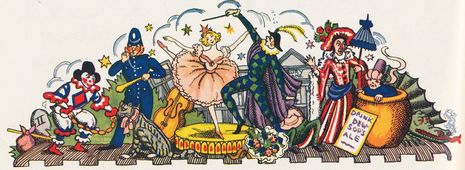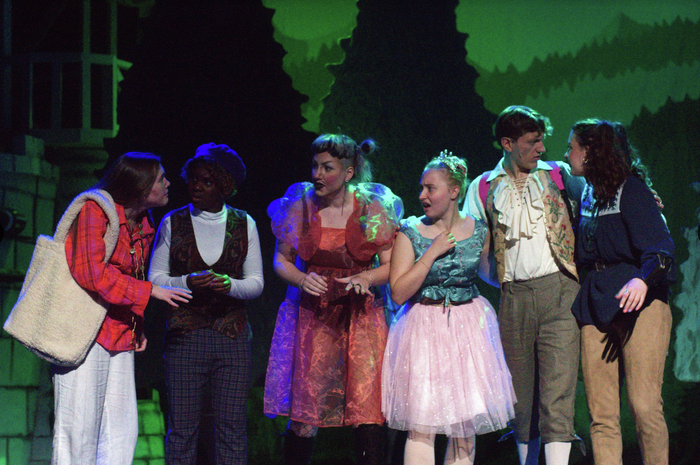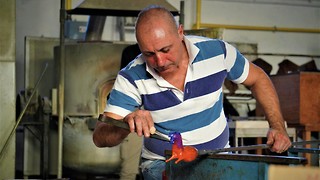The artful chaos of the Christmas panto
As the Christmas period draws to a close, Theatre Editor Georgina Hayward takes a look at the history of panto and what its enduring popularity says about theatre

Booing and cheering. Buckets of sweets. Two people dancing under a costume horse. For anyone who considers British theatre a bit snobby and self-serious (think Benedict Cumberbatch at the National, monologuing to a skull), panto has a song, some light innuendo and a generous sponge-in-the-face. It is perhaps the antithesis of what we envision when we groan about theatre elitism – the posturing and baggage that comes with daring to ‘do’ a classic. . . So what does the immense popularity of this unapologetically ‘low-brow’ genre say about what we really need from theatre?
The panto formula is easy to identify. The story is one we’ve heard before – a fairy tale with colourful costumes and pancake make-up. It’s funny. It’s silly. It’s a Christmas outing for the family, so it has to strike a careful balance between the slapstick humour understood by children and the double-entendre and topical jokes meant for adults. There has to be some gender-swapping involved: the male lead or ‘principal boy’ is often played by a woman, and his winkingly flirtatious mother is played by a middle-aged bloke in the most outrageous dress imaginable.
The uniqueness of the genre speaks to its long history. British ‘pantomime’ (not to be confused with the American usage, which refers to a mimed performance) has its origins in 16th century Italian commedia dell’arte. These plays featured stock characters, farce, and plenty of bawdy jokes. In Italy, the plot usually followed a pair of young lovers thwarting their disapproving parents. Meanwhile, in Britain, the minor figure of the Harlequin clown evolved to become the lead, and his comedy routines became the panto’s central focus.
While British critics gloomily bemoaned the popularity of these foreign imports as heralding the end of the ‘serious play’, theatre managers were quick to realise the genre’s commercial potential. ‘If they won’t come to Lear and Hamlet,’ said 18th century actor-manager David Garrick, ‘I must give them Harlequin.’
“Perhaps this kind of performance is so suitable for the festive season because it is a gift for us”
Panto has always been pitted against what we might recognise as quote-unquote artistic, yet we can recognise panto features in Shakespearean comedy. The gender-switching, the musical numbers, the self-conscious artificiality - it all has roots in a history of theatre that goes beyond our conception of high and low art. The artistry needed to make an audience of young and old people laugh is difficult to intellectualise. It is, however, a craft, and one that has endured for hundreds of years.
In the 18th century, stories about Harlequin were gradually supplanted by popular folk stories – Jack and the Beanstalk, Mother Goose, Cinderella. By the end of the Victorian era, the panto had become a British Christmas staple. Perhaps this kind of performance is so suitable for the festive season because it is a gift for us, for its audience. Our participation, our laughter is vital. From the moment Widow Twankey steps on stage and addresses the back row, we are left without a doubt: this show intends to give each and every one of us a good time. At the end of another difficult year, panto’s big-heartedness, its sense of joy, is as necessary as any contemplative makes-you-think piece of theatre.
 Comment / The (Dys)functions of student politics at Cambridge19 January 2026
Comment / The (Dys)functions of student politics at Cambridge19 January 2026 News / Local business in trademark battle with Uni over use of ‘Cambridge’17 January 2026
News / Local business in trademark battle with Uni over use of ‘Cambridge’17 January 2026 Features / Exploring Cambridge’s past, present, and future18 January 2026
Features / Exploring Cambridge’s past, present, and future18 January 2026 News / Your Party protesters rally against US action in Venezuela19 January 2026
News / Your Party protesters rally against US action in Venezuela19 January 2026 Lifestyle / Seoul food19 January 2026
Lifestyle / Seoul food19 January 2026







